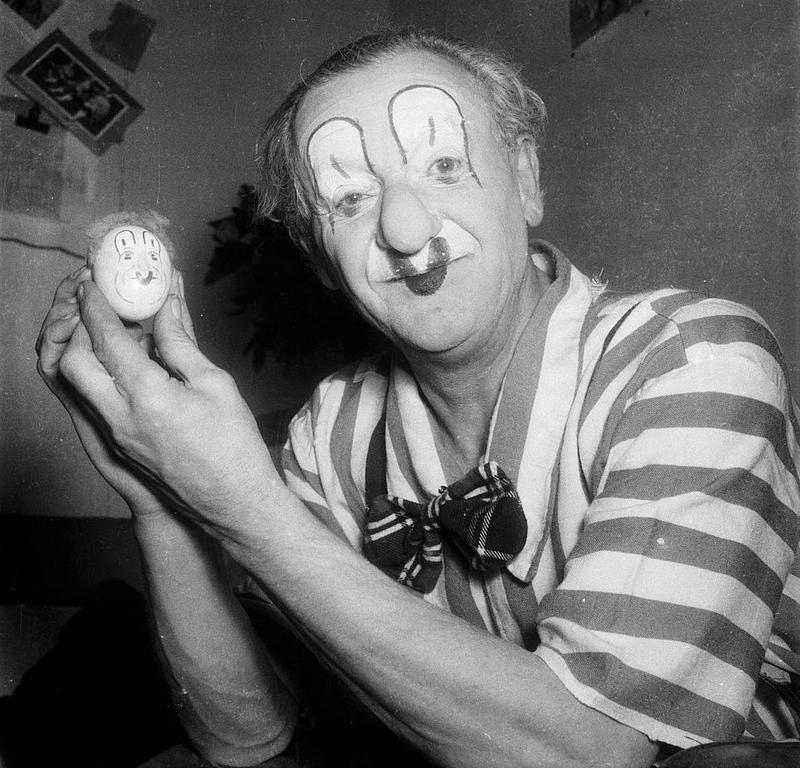Coco the Clown: The UK's Number-One Vintage Clown
By | September 22, 2020

On September 25, 1974, the entertainment world, particularly in the United Kingdom, got a little dimmer as the shining light of Coco the Clown went out forever. Before clowns became little more than horror movie villains, the lovable Coco captured the heart of a nation for over the course of a career that lasted decades.
The Man Behind The Clown
The story of the Coco the Clown is really the story of Nicolai Poliakoff, the man who created the Coco character and played the delightful clown for most of his adult life. The poor Russian Jew, born in 1900, quite literally ran away to join the circus when he was a boy, dazzled by the promise of fame and fortune. He was already at home in front of a crowd: When he was just five years old, he sang on street corners to earn money to feed his family, and later, he worked at a local theater.
At just eight years old, he took a 300-mile train ride all by himself to a town in modern-day Belarus, where a circus was headquartered. He convinced the director of the circus that he was an orphan with nowhere else to go, so the director took pity on him and placed him with a clown and acrobat named Vitaly Lazarenko, who would later become one of the Soviet Union's biggest celebrity circus performers. Poliakoff's father eventually tracked him down, but the boy wasn't ready to give up his circus dreams. He persuaded his father to apprentice him to the son of Massimiliano Truzzi, the founder of Russia's great circus dynasty. Truzzi took to calling young Poliakoff kokishka, meaning "little cat," while training him in acrobatics and trapeze. The nickname was eventually shortened to "Koko" and Anglicized to "Coco" when Poliakoff moved to the United Kingdom.

An Inspiration To All
Poliakoff stage dreams were almost dashed before they even had a chance. Although he enlisted in the Russian Imperial Army in 1915, he was conscripted into the Red Army during the subsequent Civil War. He escaped from the Red Army but was conscripted again into the White Army, so he disguised himself as a girl and hid out with a troupe of traveling performers from Mongolia until political tensions quieted down.
In 1919, Poliakoff met Valentina Novikova while he was performing in a circus in Latvia, and the couple married that year. They had six children, one of whom, Michael, followed in his father's oversize shoes. In fact, Michael Poliakoff helped design the heavily made-up mascot of McDonald's, Ronald McDonald. Michael often performed with his sister, Helen, and much later, the youngest of the Poliakoff children, Tamara, founded the first circus based in the U.K. that banned the use of performing animals.
In 1920, Poliakoff joined the newly formed Soviet state circus, and a few years later, he directed his own small circus based in Lithuania. While working for Circus Busch in Berlin, he met Bertram Mills, who invited Poliakoff to join his British circus. The Bertram Mills Circus shut down during World War II but reopened in 1946 with Polikoff's Coco the Clown as one of the star attractions.

A Star Is Born And Dies
In the British circus, Poliakoff truly shined. He was what's known as an "auguste" clown, meaning he often on the receiving end of jokes and pranks, which endeared the British people. Poliakoff's Coco the Clown appeared in all the Mills Circus performances between 1946 and the mid-1960s, leading him to become a British citizen and travel extensively across the United Kingdom. He was even knighted by Queen Elizabeth II herself.
Poliakoff continued to perform through 1973, when he toured with the Roberts Brothers Circus, but the next year, Poliakoff unexpectedly passed away after battling a short illness at 74 years old. He was laid to rest in a churchyard in Northamptonshire, England.

